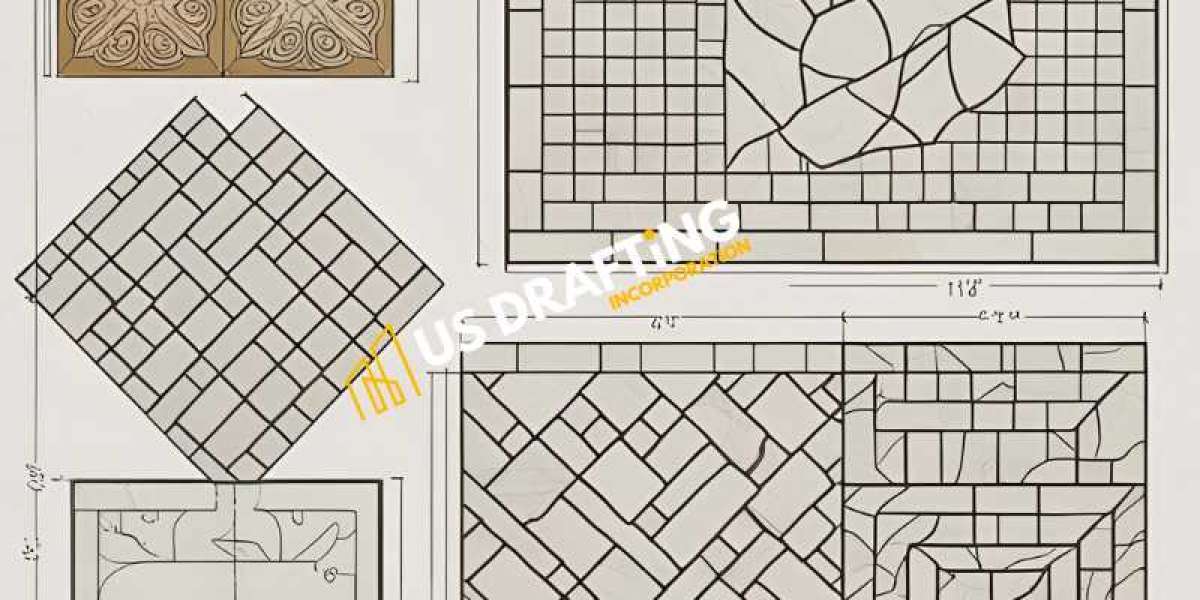Accurate and detailed shop drawings are essential in the flooring and tile industry, serving as a blueprint for successful project execution. These drawings provide a precise representation of tile layouts, material specifications, dimensions, and installation details, ensuring seamless communication between designers, contractors, and installers.
A well-prepared shop drawing minimizes errors, enhances efficiency, and ensures compliance with project requirements.
This guide explores the must-have elements in floor and tile shop drawings, highlighting key components that contribute to precision, functionality, and aesthetic appeal in flooring installations.
Purpose of Floor and Tile Shop Drawings
Floor and tile shop drawings are detailed plans that show how tiles should be placed in a space. These drawings help builders, architects, and tile installers understand the exact layout, pattern, and measurements before starting the work.
One of the main purposes of shop drawings is to ensure accuracy. They show the exact tile sizes, shapes, and colors, reducing the risk of mistakes during installation. With a clear plan, workers can follow the design without confusion, saving time and money.
Another important reason for using these drawings is coordination. They help different teams, such as architects, designers, and contractors, work together smoothly. If there are any design changes, they can be made in the drawing before installation begins, preventing costly errors.
Shop drawings also help with material planning. They show how many tiles are needed, reducing waste and ensuring that the right materials are ordered. This makes the project more efficient and cost-effective.
Also, these drawings help create a professional finish. Whether it’s a simple floor layout or a complex tile pattern, shop drawings ensure that the final result looks neat and well-organized. They also help in achieving a uniform and balanced appearance.
In summary, floor and tile shop drawings play a crucial role in construction. They improve accuracy, support teamwork, reduce waste, and help achieve a high-quality finish. By following these detailed plans, projects can be completed smoothly and successfully.
Key Elements in Floor and Tile Shop Drawings
When designing floors and tiles for a project, detailed shop drawings are essential. These drawings help builders, contractors, and installers understand exactly how the tiles should be placed. Let’s go over the key elements that make up a good floor and tile shop drawing.
1. General Layout and Overview
This section shows a complete view of the floor plan. It helps everyone see how the tiles will be arranged in the space. It includes important details like room dimensions and any special design features.
2. Tile Types and Specifications
Different projects require different types of tiles. This part of the drawing lists the tile materials, colors, finishes, and sizes. It ensures the right tiles are used in the right places.
3. Tile Layout and Pattern Details
Tiles can be arranged in various patterns, such as straight, diagonal, or herringbone. The shop drawing includes details on how the tiles should be laid out to achieve the desired look.
4. Dimensions and Measurement Details
Precise measurements are crucial for a successful installation. This section includes the exact sizes of tiles, spacing between them, and how they fit within the floor area.
5. Grout and Joint Details
Grout is the material used to fill the spaces between tiles. The shop drawing specifies the grout color, width, and type to ensure a uniform and professional finish.
6. Edge and Border Details
The edges of a tiled floor must be carefully finished. This part of the drawing shows how borders and edges should be treated, such as adding trim pieces or special cuts.
7. Special Features and Custom Elements
Some projects may have unique tile designs, such as mosaics, medallions, or special inlays. This section highlights these custom elements and provides instructions on how to install them correctly.
8. Substrate and Underlayment Details
Tiles need a solid foundation to last long. This part of the drawing specifies what materials should be used underneath the tiles, such as concrete, plywood, or waterproof membranes.
Benefits of Well-Prepared Tile Shop Drawings
Tile shop drawings play a crucial role in ensuring a smooth and successful tiling project. These detailed plans help architects, contractors, and tile installers work efficiently while avoiding costly mistakes. Here are some key benefits of well-prepared tile shop drawings:
1. Accurate Installation
Tile shop drawings provide precise layouts, dimensions, and patterns. This accuracy helps installers place tiles correctly, ensuring a neat and professional finish.
2. Better Planning and Coordination
With detailed drawings, teams can plan the project efficiently. It helps in coordinating with other trades like plumbing and electrical work, preventing conflicts during installation.
3. Material Optimization
A well-prepared drawing helps in estimating the exact quantity of tiles needed. This reduces material wastage and helps in cost savings. It also ensures that special tiles, such as borders or accent pieces, are ordered in advance.
4. Error Prevention
Mistakes in tile placement can be expensive and time-consuming to fix. Shop drawings minimize errors by providing a clear guide for installers, reducing the chances of incorrect cuts or misaligned patterns.
5. Improved Client Satisfaction
When clients can see the design before installation, they can request changes if needed. This ensures they get the look they desire, leading to higher satisfaction.
In summary, well-prepared tile shop drawings save time, reduce waste, prevent errors, and enhance the final outcome of a project. They are an essential tool for any successful tiling job.
The End Note
Floor and tile shop drawings are indispensable tools in the construction and design process, ensuring precision, efficiency, and a high-quality finish. By incorporating essential elements such as accurate layouts, material specifications, dimensions, and installation details, these drawings streamline coordination between architects, contractors, and installers.
They help minimize errors, optimize material usage, and enhance project planning, ultimately leading to cost savings and improved client satisfaction. A well-prepared shop drawing serves as a clear roadmap, guiding the installation process and ensuring that the final result aligns with the intended design.
In the flooring and tile industry, investing time and effort into detailed shop drawings is key to achieving a seamless, professional, and aesthetically pleasing outcome.



